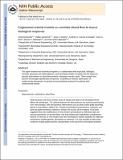| dc.contributor.author | Santoma, Pablo | |
| dc.contributor.author | Molins, Jose J. | |
| dc.contributor.author | Garcia-Granada, Andres A. | |
| dc.contributor.author | Bea, Jose A. | |
| dc.contributor.author | Balcells-Camps, Mercedes | |
| dc.contributor.author | Martorell Lopez, Jordi | |
| dc.contributor.author | Edelman, Elazer R | |
| dc.date.accessioned | 2016-05-22T20:14:30Z | |
| dc.date.available | 2016-05-22T20:14:30Z | |
| dc.date.issued | 2012-04 | |
| dc.identifier.issn | 00778923 | |
| dc.identifier.issn | 1749-6632 | |
| dc.identifier.uri | http://hdl.handle.net/1721.1/102577 | |
| dc.description.abstract | This paper reviews how biomedical engineers, in collaboration with physicians, biologists, chemists, physicists, and mathematicians, have developed models to explain how the impact of vascular interventions on blood flow predicts subsequent vascular repair. These models have become increasingly sophisticated and precise, propelling us toward optimization of cardiovascular therapeutics in general and personalizing treatments for patients with cardiovascular disease. | en_US |
| dc.description.sponsorship | Spain. Ministerio de Ciencia e Innovacion (Plan Nacional BFU2009-09804) | en_US |
| dc.description.sponsorship | National Institutes of Health (U.S.) (Grant NIH/NIGMS RO1/GM049039) | en_US |
| dc.description.sponsorship | Spain. Generalitat de Catalunya (FI-DGR 2011) | en_US |
| dc.description.sponsorship | Barcelona Chamber of Commerce | en_US |
| dc.description.sponsorship | Fundacao Empreses IQS | en_US |
| dc.description.sponsorship | POSIMAT | en_US |
| dc.language.iso | en_US | |
| dc.publisher | Wiley Blackwell | en_US |
| dc.relation.isversionof | http://dx.doi.org/10.1111/j.1749-6632.2012.06518.x | en_US |
| dc.rights | Creative Commons Attribution-Noncommercial-Share Alike | en_US |
| dc.rights.uri | http://creativecommons.org/licenses/by-nc-sa/4.0/ | en_US |
| dc.source | PMC | en_US |
| dc.title | Engineered arterial models to correlate blood flow to tissue biological response | en_US |
| dc.type | Article | en_US |
| dc.identifier.citation | Martorell, Jordi, Pablo Santoma, Jose J. Molins, Andres A. Garcia-Granada, Jose A. Bea, Elazer R. Edelman, and Mercedes Balcells. “Engineered Arterial Models to Correlate Blood Flow to Tissue Biological Response.” Annals of the New York Academy of Sciences 1254, no. 1 (April 2012): 51–56. | en_US |
| dc.contributor.department | Massachusetts Institute of Technology. Institute for Medical Engineering & Science | en_US |
| dc.contributor.department | Harvard University--MIT Division of Health Sciences and Technology | en_US |
| dc.contributor.mitauthor | Martorell, Jordi | en_US |
| dc.contributor.mitauthor | Santoma, Pablo | en_US |
| dc.contributor.mitauthor | Edelman, Elazer R. | en_US |
| dc.contributor.mitauthor | Balcells-Camps, Mercedes | en_US |
| dc.relation.journal | Annals of the New York Academy of Sciences | en_US |
| dc.eprint.version | Author's final manuscript | en_US |
| dc.type.uri | http://purl.org/eprint/type/JournalArticle | en_US |
| eprint.status | http://purl.org/eprint/status/PeerReviewed | en_US |
| dspace.orderedauthors | Martorell, Jordi; Santoma, Pablo; Molins, Jose J.; Garcia-Granada, Andres A.; Bea, Jose A.; Edelman, Elazer R.; Balcells, Mercedes | en_US |
| dspace.embargo.terms | N | en_US |
| dc.identifier.orcid | https://orcid.org/0000-0002-7832-7156 | |
| mit.license | OPEN_ACCESS_POLICY | en_US |
| mit.metadata.status | Complete | |
